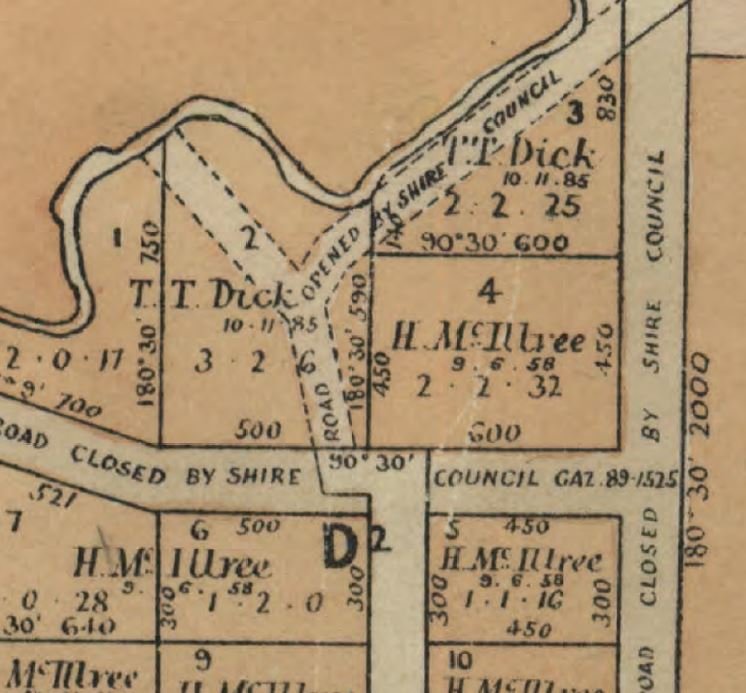DR DICK’S VINEYARD
If you heard the phrase “Wineries of North East Victoria” you would no doubt think of Rutherglen or the King Valley regions. But, 100 years ago you could count Wodonga among Victoria’s wine districts – boasting a number of vineyards that these days you’d consider fairly close to town.
his story focuses on one of these – undoubtedly the most central of all of our old vineyards, it was situated in a little pocket of town that many in Wodonga would drive past every day, and where dozens of homes now sit on land once covered in grapevines.
Take a drive down South Street past Church Street Hotel and you’re now in old Wodonga wine country. Take a right turn down Dick Street and you’re really in the thick of things. After all, Dick Street was named for the former owner of the vineyard that covered 40 acres of land between South Street and Sumsion Gardens, or more broadly speaking, Belvoir Park.
Thomas Dick planted his first vines on the west side of what is now Batt Avenue, towards the Bank Street end. This was land that had been farmed for decades by the time Dick purchased it – owned by the McIlree family since 1857. The earliest mention of Dick’s vineyard on this land is from 1883 when the local paper reported that he was trying to convince the local council to sell him a strip of land serving as a road, something he described as valueless.
Dick had been spending up big in town, pumping more than £3,000 into the local economy while getting his vineyard up and running. He thought the council would be happy to grant his request as the local wine industry was taking off and they would be happy to support it. While I couldn’t find a follow-up article, Dick seems to have been successful in getting the strip of land sold to him, as it formed part of his extensive land holdings years later.
Thomas Thomson Dick was better known professionally as Dr Thomas Thomson Dick – a medical doctor of Scottish descent who had attended Edinburgh University. He spent his early years in the Colony of Victoria based in Melbourne as Superintendent of the Yarra Bend Asylum. For those who have never heard of the Yarra Bend asylum, it was Victoria’s first official asylum – demolished almost a century ago it was located on where the Yarra Bend Golf Club is now, just south of the Eastern Freeway entry at Clifton Hill. Before Yarra Bend was built, Victoria’s prisons were where the, using the language of the time…”Lunatics”, were held. With a growing population, one major factor being an influx of people into the colony during the gold rush, Yarra bend was becoming overcrowded and the idea was to build a few more asylums around the colony to deal with the pressure. The Beechworth Asylum was built in response – as were the Kew and Ararat asylums. So what does this have to do with a Vineyard in Wodonga? The man picked for the top job at the new Beechworth Asylum was Dr Thomas Thomson Dick. The Asylum opened in 1867 and Dr Dick was employed as the first Superintendent for the institution.
It must have been during his time at Beechworth that he ventured to Wodonga for one reason or another and decided that the slightly higher ground overlooking Belvoir Park might be suitable for a vineyard. Though, it would be a while before he acted on this – with a move back to Melbourne occurring in 1877 when Dr Dick was appointed as the superintendent of the Kew Asylum. It would be another five or six years before Dick made his mark on the South Street landscape.
By 1889 Dick had 21 acres of vines - and business must have been going along alright, in December 1889 he had put out for tender the erection and completion of a large brick wine cellar at his Wodonga Vineyard. Plans for which could be viewed at the offices of Gordon and Gordon – a local firm of architects responsible for quite a number of well-known North East buildings including St Patrick’s Church in Albury, ‘Fairfield’ homestead at Brown’s Plains and the Old Tallangatta Shire Offices.
Reports from as early as January 1890 refer to Dr Dick’s Wine Cellars, so it appears work did not take long at all. That same year, Wodonga was getting a name for itself in the world of colonial wine. Signor Allesandro Romeo Bragato, the government wine expert who was employed by the Department of Agriculture, visited the wine regions of the North East. At a function held in Wodonga by the Wodonga Winegrowers Association, Bragato addressed the local winemakers and praised them for their Riesling, Malbec and Shiraz – something the Wodonga wineries evidently did pretty well, Bragato even went as far to say that these varieties produced locally surpassed even those in the Rutherglen District.
In terms of the overall wine industry in Australia – Bragato also told the winegrowers that there was no risk of oversupply – saying there was “an absolutely illimitable market in Europe for all the wine that could possibly be raised, even if every acre in Australia were under vines”.
Born in what was then part of the Austrian Empire but is better known today as Croatia – Bragato graduated from Italy’s oldest and most prestigious wine school, the Scuola Enolgica in 1883. After graduating he was an oenologist (and yes, I had to look that up it's no surprise it means an expert in wine and winemaking) for the Provincial Association of Agriculture for a number of years before working as a viticulturist and cellar master.
He arrived in Victoria in 1888 and wasted no time getting involved in the Victorian wine industry, submitting a report to the Government where he advocated for a school of oenology and viticulture to be established to produce “intelligent viticulturists and winemakers”.
It wasn’t long and Bragato had found his way into the position of Victorian Government Viticulturist.
After Signor Bragato’s visit, it was theorised that while Wodonga had a number of good vintages, it was their modesty that kept them out of the spotlight. Compared to the winemakers of Rutherglen, the Wodonga growers didn’t enter their wines in the town fairs or shows in the district all too often.
Though, that wasn’t to say the Wodonga wines weren’t often on the tasting list at these shows…but, they were brought there by the Rutherglen winegrowers. In what was reported as a well-known fact, it was alleged that before any big show, certain winemakers from the Rutherglen region would visit the cellars of the Wodonga vineyards and take away with them a couple of bottles of our best vintages – then, these shady characters would exhibit the Wodonga wine as their own!
The Wodonga growers didn’t appear to show their wines locally or in neighbouring districts but they were given the opportunity to be exhibited a little further away – in Paris. In 1898 Bragato returned to the Wodonga Wine district and spent a few days with a view to selecting vintages for the Great Exhibition in Paris in 1900 – Dr Dick’s wine was among them.
So what happened to Dr Dick’s Vineyard?
From the research I’ve been able to pull together – it was the combination of a number of events that led to the demise of Dr Dicks Vineyard. The first was a pest called Phylloxera – a small yellow insect, similar to an aphid which feeds on the roots and leaves of vines. This pest arrived in Australia from France in the 1870s and made its way through the Victorian vineyards from the Bellarine Peninsula to the Murray.
By the early 1900s the pest had made its way up to the North East – and while work was being done to import resistant rootstock from overseas (mainly America) there was a strong ‘eradication’ policy at the time which saw entire vineyards being uprooted with many vignerons choosing not to replant. Dr Dicks vineyard wasn’t spared – in 1908 half an acre of his crop was destroyed and had to be uprooted, in 1913 another 40 acres had been affected.
The next event to affect the future of the vineyard was the death of Dr Dick himself in 1919. Dick had never married and his estate was left to the public trustee. His land holdings in Wodonga were significant – at the time of his death he owned all but a few small blocks between South Street and Sumsion Gardens/Belvoir Park where the bulk of his vineyard was located. He also owned the land where today you’ll find Peards Wodonga, Mitre 10, Vic Roads, the electrical substation, Begley’s Backyard, Watson Street Storage and RV world.
Option was given to Octavius Batt to purchase the vineyard allotments and to continue on with operating the vineyard, but it seems that even with the generous offer that Dr Dick had made, it was too expensive for him to carry on given the continued threat of phylloxera potentially wiping out any future stock. It should be noted too that after Dr Dick’s retirement from the public service – he was on a pension of £1,000 per annum – allowing him to support himself through any downturns, a luxury Octavius Batt would not have had.
The land would eventually be put up for sale and in December 1924 advertisements for 26 “beautiful building allotments, right in the heart of Wodonga”. Adverts in 1929 show an additional 31 choice building allotment at “Dick’s Estate”.
Today we know Dr Dicks as the houses in and around Dick Street, Octavius Street, and Batt Street…I wonder where they got those names from?
Wodonga Rates; 1888 - showing Dick's many blocks
Wodonga Rates; 1889 - mentioning vineyard and house
Wodonga Township Plan - Dick would own most of the land in this area at one stage
Signor Allesandro Romeo Bragato -- wine expert





